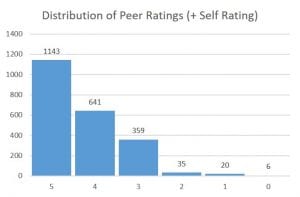Update: Now with complete set of data (previously still with 5% not in yet).
I’m in the process of collating your peer review for the Special Project. It’s quite interesting. If I managed to find time, I’ll post some basic analysis. The overall impression reading the comments on group dynamics is that most students had a positive experience with the group–in some cases, even a very positive experience. But there are a few (up to a handful, out of 85 groups) that didn’t quite work out well. The tutors will follow up where necessary. It’s unfortunate, but it’s also hard to guarantee that everything will go swimmingly in a class of 400+.
One comment, however, was disappointing, for a different reason:
…wanted to feedback that the project instructions were unclear. Only a week before the due date was the project requirements released. This resulted in us having to painstakingly cut our 4 min video to 2min…
The time limit for the short video was mentioned on L01 Slide #17–that’s the very first, introduction lecture. In addition, one set of basic instructions for the Special Project was posted on the Course Blog here (last dated 26 September). The Poster linked from there contains all the really essential requirements, deadlines, etc. That post was also linked from early on from IVLE homepage of the module, and Lesson Plan. The more detailed instructions in IVLE Files are more for the submission process.
* * * * *
Some basic analysis of the review results. The number of students who participated in the Peer Review = 374 (85% of enrollment), contributing 1,957 individual peer ratings (for the first question). These are distributed as follows:
- Rating of 0 = 7 (0.4%)
- Rating of 1 = 18 (0.9%)
- Rating of 2 = 49 (2.5%)
- Rating of 3 = 366 (18.7%)
- Rating of 4 = 660 (33.7%)
- Rating of 5 = 857 (43.8%)
The average score is 4.16, and the median is 4.00. First impression from the numericals is that the vast majority of students are quite happy with their group members–77.5% of the ratings are 4s and 5s.
Now, the general impression is also confirmed when we turn to the “further general comments” (the third question). Each response was tagged under three categories–“at least somewhat negative”, “neutral/indifferent”, “generally positive”, and “very positive”. Those who provided no response are tagged as “neutral/indifferent” (makes the bulk of this category). The breakdown of the responses is as follows:
- Very positive = 101 (27.0% of respondents)
- Generally positive = 74 (19.8% of respondents)
- Neutral/indifferent = 184 (49.2% of respondents)
- At least somewhat negative = 15 (4.0% of respondents)
The “at least somewhat negative” tag was applied liberally–as long as there is some small thing, even if the rest of the comment was positive. The 15 comments in this category came from 12 different groups and they break down as follows:
- About a non-participating member — 4 (from two different groups)
- About (perceived) workload distribution issues — 2
- About lack of communication or synergy, or bossy member — 5
- About the lack of motivation among members — 2
- “It was not a really pleasant experience” — 1
- The project should count for more in the grades — 1
The 74 “generally positive” comments are too many for me to fully sum up, but the recurring themes are about how the group was “cooperative”, “efficient”, and “worked well together”, or that “all members contributed”, so that the overall experience was “generally pleasant”.
The 100 “very positive” comments are also too many for me to fully sum up, but there are recurring themes as well. Respondents speak of how they had much “fun” working on the project together, that the fellow members were “great to work with”, that the overall experience was a “very good” one. Several spoke of how theirs was an “awesome” group, or that this was the “best group project” they’ve been involved in.
For now, the general impression is a positive one–the vast majority of students very probably had at least an okay time with their group, while a strong plurality (46.8%) had a generally positive to very positive time with their group.
* * * * *
(Your tutors and I are picking through the internals more carefully to see if there’s any specific issues we need to investigate further.)
(Watch this space…)
 I’m in the process of collating your peer review for the Special Project. The overall impression reading the comments on group dynamics is that most students had a positive experience with the group–in some cases, even a very positive experience. I won’t have time to post extensive analysis of the qualitative comments but the attached wordcloud for Question 4 (“Any further general comments about your project group”) created using https://www.wordclouds.com/ gives you a sense of the overall situation. (Click on the graphics to see a larger version.)
I’m in the process of collating your peer review for the Special Project. The overall impression reading the comments on group dynamics is that most students had a positive experience with the group–in some cases, even a very positive experience. I won’t have time to post extensive analysis of the qualitative comments but the attached wordcloud for Question 4 (“Any further general comments about your project group”) created using https://www.wordclouds.com/ gives you a sense of the overall situation. (Click on the graphics to see a larger version.)


